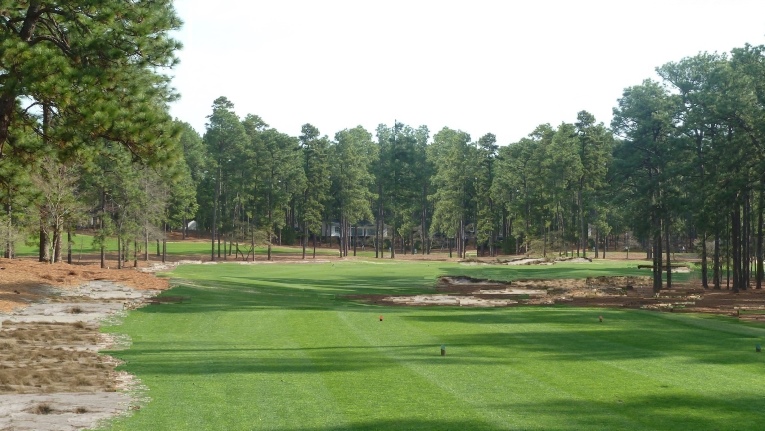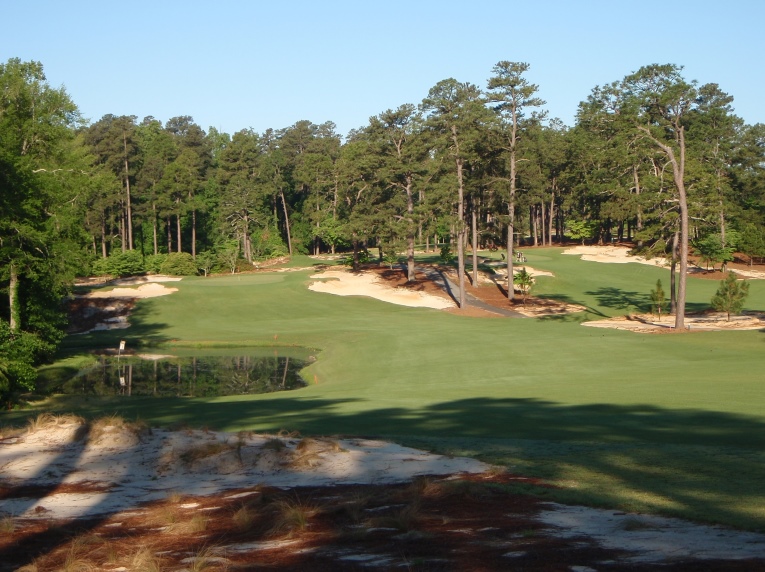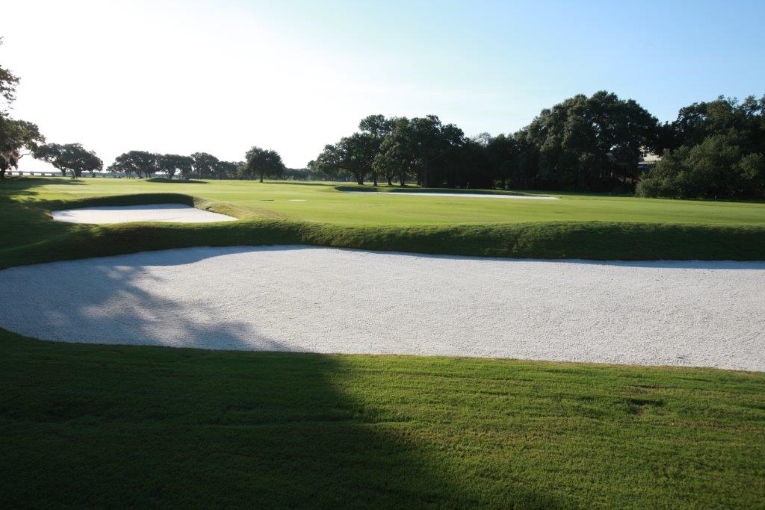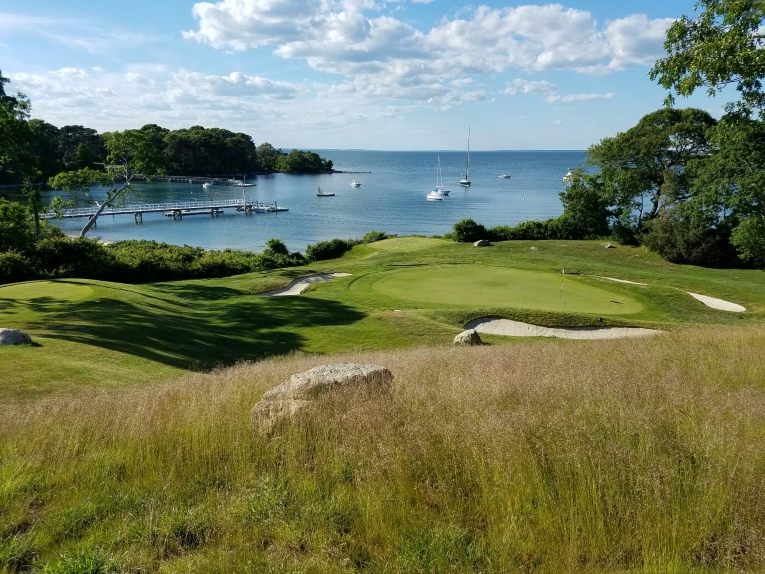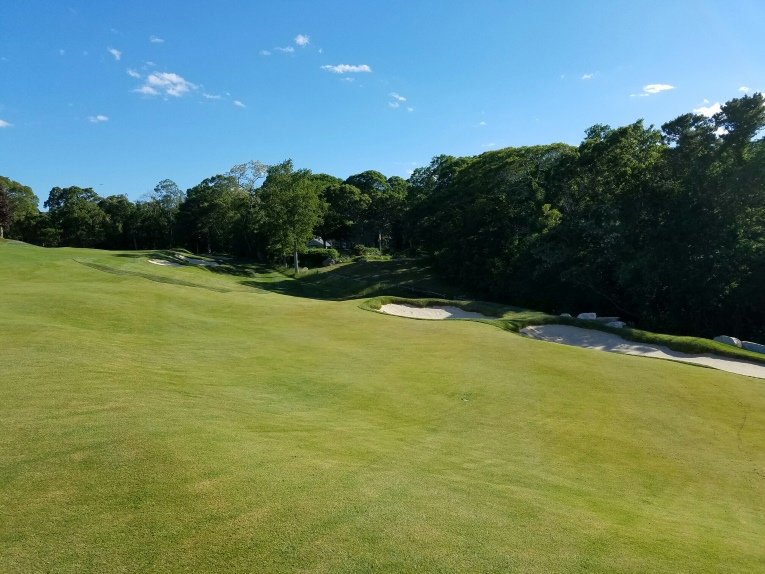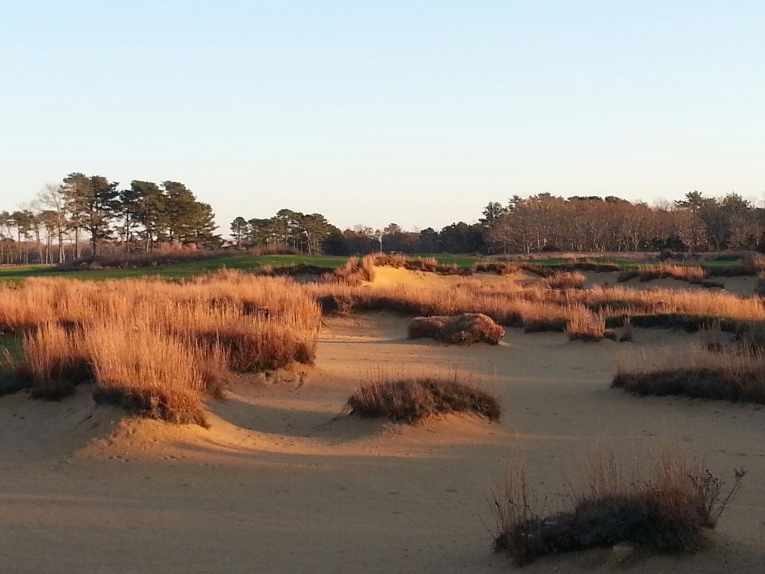Feature Interview No. 2 with Kyle Franz
August, 2016
Since his June 2011 GolfClubAtlas interview, Kyle Franz has worked for Gil Hanse on the Rio 2016 Olympic Golf Course and completed his first solo work as an architect at Mid Pines, where he restored the course to acclaim – and increased foot traffic. Mid Pines now receives as many rounds as its more famous sister course Pine Needles. Kyle is currently busy with solo work at the Country Club of Charleston, which will host the 2019 U.S. Women’s Open, and Pine Needles which will host the U.S. Senior Women’s Open that same year. Other work on the go includes Minikahda Club, home of the 2017 U.S. Senior Amateur Championship, and Woods Hole Golf Club on Cape Cod.
Let’s start with the Olympic Course. What are the key characteristics of the property? Which holes will be the most exciting from a viewing standpoint? And which elements of the design will have the greatest influence on who takes home the gold medals?
Before we get into details, I’d like to start by thanking Gil Hanse and Jim Wagner for giving me the opportunity to participate on the project. It was a tremendous honor to be involved in such an amazing and historic project with golf returning to the Games and ranks with Pinehurst #2, Pacific Dunes and Barnbougle as career highlights. I can’t offer enough accolades for Gil’s fantastic design, leadership and supreme talent for handling the sizable political complexities of the project. The entire project team deserves a standing ovation for the work on the ground. The bunker shaping by Neil Cameron evokes some of my personal favorites in Australia’s Sand Belt. The bunker finish work and native grass transplant by Ben Hillard from Melbourne and Benjamin Warren from North Berwick were crucial to dialing in the rugged Aussie look of the course so quickly. Jim Wagner’s (Gil’s partner and brilliant mad scientist) unique contributions on holes like #4 and others make them arguably the best on the course.
As for what to expect during the Olympics, the course is playable, exciting and memorable down the stretch. Several holes fit in the category I most value in architecture — they are fresh and intriguing concepts — instead of predictable repetitions even good architects fall into occasionally. The property itself is sweeping and sandy and reminiscent of the Australian Sand Belt. It also might remind some of how Lido felt when MacDonald and Raynor completed it.
Technically speaking, the landscape is a coastal deflation plain dunesland. It sits about 300 yards back from the frontal dune system and beach, buffered by the Marapendi Lagoon. A succession of smaller dune ridges runs back through the property. The smaller rippling elements we preserved and/or created were meant to bring out as much Old Course and North Berwick shot making as warm season grasses will allow. Pinehurst #2 style sandy native areas guard “one cut fairways” and gives the holes exciting width and strategy at margins. Many times the viewer will notice the grassing lines define the strategy of the hole.
After 40 years of sand mining, areas of the site were degraded with invasive species and illegal dumping. Our first task was to put it back together dune by dune over Gil’s excellent routing and grading plan. In doing so, we created a golf course that hopefully captures a little of the strengths of the aforementioned courses and the native landscape.
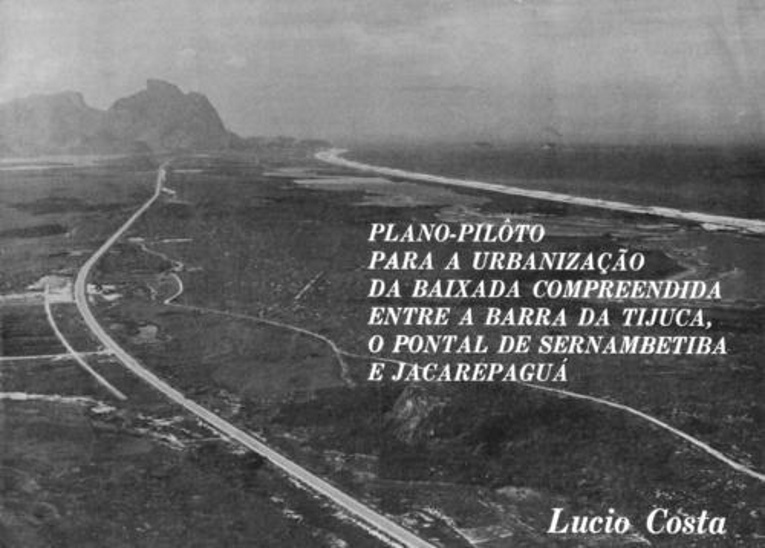
The low dunelands in the 1940’s that would eventually become the Rio Olympic Course (the exact middle of photo would be roughly the 15th green).
Overall the golf course has a really nice flow. The most interesting holes to watch are where we created some of the more unique architectural features and include the sporty holes down the stretch. The difficult 12th and 13th play through dense jungle. The 13th green complex is one of the course’s most demanding. The 14th is a long par three that would be completely at home at Kingston Heath or Royal Melbourne. It’s impossible to imagine the drivable 16th not having a defining impact on the events. It’s a hole where there is more than meets the eye thanks to multi-dimensional hole locations.
Also, eighteen is a very cool mid-length par five that’s green complex is a blend of the 18th holes at Dornoch, St Andrews and North Berwick. The prominent feature is a broad “Valley of Sin” style hollow front right of the green. A “Foxy” style mound further complicates shots for “Sinners.” However, the most exciting feature is the #18 at Dornoch inspired kicker front left of the green. This feature will curl balls around the hollow to right pins. The players that learn that there is a covert advantage by playing shots there will have the advantage – especially in windy conditions. It will be interesting to watch the ladies event since they are so accurate and more likely to play ground shots in competition than the aerial attack of the men.
Earlier in the round viewers should note:
Hole #1: The players must navigate a shortgrass dune ridge in front of this par 5 green that demands a perfectly controlled up-and-over running approach to a fallaway green. This is a type shot they are rarely asked to play at modern tournament venues.
Hole #2: This sweeping dogleg’s green is flanked by a lagoon. The tee shot has a classic speed-slot landing area for players that attack bunkers on the dogleg interior. The green has an array of high right and low left hole locations that give players ground and aerial shot options to avoid the lagoon. This is a hole I think will play very interesting for the ladies event for the reasons described above.
Hole #3: The first of two drivable par fours, the third stands out as arguably the most original hole on the golf course. I really can’t think of a comparison. It plays alongside a pond that we created amongst the low dunes. The green is a massive rendition of a double plateau. The strategy of this hole has the potential to change dramatically day to day depending on the varying hole locations.
Hole #4: There’s no hole that is more Melbourne on steroids than the fourth. Jim Wagner sited a bold green on one of the bigger dune ridges on the site, which he then proceeded to build even higher and front with a menacing Royal Melbourne style bunker. Really great stuff.
Hole #9: The quirky and entertaining 13th at Fraserburgh contributed to the design of this green complex. It will encourage cool ground game shots from the Olympic competitors off two large front mounds if the course is extremely windy and firm. However in calm conditions it is a respite similar to the 9th at St Andrews – an exciting break between more difficult holes. In calm conditions players can use the interior green contours to spin shots to hole locations behind the mounds – making it a definite birdie hole.
Controversy is never far from the development of Olympic venues and the Rio golf course project was no different. What was it like working in such a media fish bowl?
I don’t know what everyone was talking about— this was the easiest project ever! Joking aside, many projects are complicated by factors out of our control. It just happened this time it was under the media spotlight. So for a long time I’ve been ready for the focus to shift to how well the golf course turned out.
I’ll say something that would shock people who aren’t involved in golf design and construction day to day. While challenging at times, the delays in Rio benefitted the course and project because we had something that is a rarity in modern golf architecture: virtually unlimited time during the shaping phase. Of the 18 holes, roughly 14 of them went through some kind of positive metamorphosis and editorial because we had that extra time. And of that list, many of them are among the best holes with the aforementioned 3rd being a prime example. As I have heard Bill Coore and Ben Crenshaw say many times “there is simply no substitute for time in architecture.”
Certainly the pressure was like no other on this project. Some days the fastest way to find out what cockamamie saga was going on out of our control was getting on NBCSports.com or yahoosports.com. I can’t give Gil enough credit for how he handled all that and took all the pressure off of us, thus freeing us to focus on the task at hand.
Does the final product stack up with your personal hopes prior to the project? Beyond the Games, what type of legacy will the course create?
The final product exceeds my expectations. The extra time was invaluable in creating something special. As for the course’s legacy, for me it was important to be able to contribute to something that transcends Rio 2016. I think we did that – it is a very playable course with lots of short grass. It was equally about the opportunity to do something that might help grow the game in South America – as Brazil’s first public course. Obviously being a part of the Olympics was exciting, but long-term hopefully the course will be a springboard for the growth of the game in South America, which possesses incredible landscapes – from Brazil to Chile and Argentina- and amazing coastlines. For sure, the course sends the right message that the golf can be fun and rewarding. Any impact our work might have to help spur thoughtful architecture and development down there would be humbling.
With warm season grasses, how firm and fast will conditions be in Rio in August (their winter)? Fast enough to where the ground game options will flourish? How much will the wind be a factor?
The golf course is going to play as firm and fast as possible for warm season grasses for the event. The sandy soils couldn’t be more well-suited to it. It’s probably the best draining sand I’ve ever work with. Gil and Jim specifically chose Zoysia fairways and Paspalum for the greens to ensure the surfaces are at their firmest and fastest during the Olympic period. Superintendent Neil Cleverly has been preparing for just that.
There’s potential for some notable wind during the Olympic events. Like on any seaside course, two or three club winds are common. The property has occasional calm days but it can also be a lot windier in August. We did a wind chart during the project and found August to be the windiest month. It shifts often during the month as well. As I was building the 18th green in August 2013, the hole played into a British Open quality headwind. As I was finishing and preparing the green for grassing a year later, we had one of the biggest wind storms of the project from the dead opposite direction. As a result we tried to get all the details to play well in both winds.
As mentioned several of the holes have ground game features that were inspired by the great UK links. I am especially excited to see some wind during the ladies tournament. Holes like the 2nd, 9th, 10th, 13th, 14th, and 18th will be particular interesting for them from the ground game perspective if the winds are up.
Overall the 10th green has a 12th at St Andrews-feeling front left hole location. Wedging in there is very challenging and I fully expect to see even men consider skipping it up. The kicker options on the 2nd hole will come into play for ladies, especially if there’s a wind off the right.
The 13th fairway is inspired by “The Kitchen” at Royal St George’s. If players make it to the right section they’ll get the keys to the kingdom in being able to attack a tricky green from a level lie. On the bail side of the tee shot, players will have to deal with a rat’s nest of hanging lies from long range – likely requiring a running shot for even top caliber men if the lie is awkward enough.
These flyovers offer a nice look at the holes for prepping to watch the event: http://www.golfdigest.com/sto…/the-olympic-course-experience .
Let’s talk about your work at Mid Pines, a course you fell in love with during the Coore & Crenshaw Pinehurst #2 restoration. How did you tackle the project? And what sources did you reference when creating your restoration plan?
Well it certainly was a dream come true! My interest in the course was initially stirred by Pinehurst superintendent Kevin Robinson, who informed me that Donald Ross’s greens at Mid Pines had never really been changed over the decades. I fell in love with the course for that very reason throughout the winter of 2011. For Coore & Crenshaw’s Pinehurst #2 project, I spent many days researching and studying historic photos in the Tufts Archives. I kept coming across pictures of the other area courses that I thought would be valuable for our work at #2. The shots of Mid Pines in particular were impressive. I would take pictures out on the course and visualize the original holes. That was really where the idea was seeded in my mind. I did some photoshops for Kelly Miller, President/Owner of the resort to illustrate what the golf course would look like if we embarked on the same process as #2.
Having gone through a restoration at Pine Needles, they’d already acquired a 1939 Mid Pines aerial. In terms of sources a lot of the project was also improvisation from what I had learned at #2 and the unique style of the Mid Pines Ross intended. I will explain that in detail below. That experience at #2 meant I didn’t have the type of learning curve that most other architects would have had when trying to get into a Ross mindset and implementation.
The project scope covered these key areas: recovering the artistry of Ross’s original bunkering and sandy wiregrass areas, expanding/modifying green edges to restore lost pin positions, widening fairways, recreating shortgrass green surrounds and finally, tree clearing. All those categories had the effect of reinstating playing angles. I also hoped in the process we could explore some of the more avant-garde quirks of Ross’s unique Pinehurst style that we never found the right spot to implement at Pinehurst #2. After the #2 project I had a strong vision for doing the extremely sand flashed face bunkers Ross built in the 1930’s at Mid Pines. At our Pinehurst #2 project we had specifically mimicked his more 40’s era style bunkers – half grass faced and half sand flashes. At Mid Pines we went all out to mimic the highest 30’s flashes. I felt it would be unique between the two courses and visually impressive with the course’s vistas.
We had an excellent team over the course of the project that comprised of George Waters, Kye Goalby, Zach Varty, Jonathan Reisetter, Jaeger Kovich, Dan Proctor, Bryan Ceasar, Norbert Painter and Jeff Stein to achieve this. Last but not least Jose Avila — one of our key assets on the #2 project – served as lead foreman restoring the native grass in the sandy hardpan areas and bunkers.
What are some of your favorite holes/shots now at Mid Pines?
As for holes to note, the first hole is an opening hole Donald Ross standout with its sweeping vista. It has subtle strategy from the tee and deft shots around the green, that capture the ambience of the course and property from the start.
On the drive and pitch 4th, a tree on the right edge of the fairway demands that the golfer hold their tee shot up on the left side to have the premium attack angle. This hole has been stirring controversy since we started the restoration project. It’s right in the wheelhouse of Ross’s design style – a blood pumping tee shot combined with tempting ground game options. Great architecture should stir the emotions and provoke discussion and as you know Ran, this hole has had no shortage!
The par five 6th is a classic example of Ross par 5 bunker placement – carefully dictating various contrasting strategic routes to reach a tiny, false fronted green.
Ross’s sweeping ground game shot options are best exemplified when attacking the front right pins on the 7th. You can play all the way out to the left and swing down to the hole – wisely taking the front right bunker out of play.
The par four twelfth I believe is pound for pound the best hole out there. It has an enormous fairway but you really need to hit the left side next to the litany of hazards we restored. It probably puts more of a premium on placement that any other hole. The long par three thirteenth is a brutal hole with a semi-redanish green concept. If you get the ball chasing right to left in front of the green it will continue to do so on the putting surface. But there are also some pins that prefer a fade.
Mid Pines’ closing stretch of par 4s is outstanding. #16 and #17 have cool options and tricky greens. The 18th probably best exemplifies Ross’s Mid Pines concept of a huge fairway in a tight corridor.
What are the key differences between Ross’s design work at Pinhurst No.2 and Mid Pines?
The main difference in Pinehurst #2 and Mid Pines is that Ross was designing a player’s club at Mid Pines. Pinehurst was supposed to be a brutal and demanding course from the back tees but playable for the average guest. Mid Pines was supposed to be a much harder course than the other courses in the area, and was the first the Tufts family developed away from the resort. Ross and Oakmont’s William Fownes — who was obviously a very good player and loved a good hard golf course — were looking to create a more challenging private club experience.
Here was Ross’s main tactic to achieve this at Mid Pines. While the fairways at Mid Pines are as wide as Pinehurst #2’s, the clearing corridors are considerably tighter. Pinehurst #2’s fairway corridors average about 65 to 80 yards. Mid Pines has the same width fairways but the clearing corridors are often 15 or 30 yards narrower than that. In many cases at Mid Pines there was no buffer between fairway and the pine trees, wisteria and dense thickets of wiregrass. While Pinehurst #2 had its iconic large expanses of sandy hardpan and wiregrass, there’s was little margin for error at Mid Pines. Ross even transplanted trees from the center of the corridors to thicken things up at the edge of the fairways.
The greenside bunker arrangements require careful strategic play from the tee – and demand that players hit sides of fairways. The photo of the restored 5th with its 15 to 20 foot deep bunker illustrates that nicely. There was also a notable increase in bunkers closely flanking both sides of the green. Bail out room was scarce at Mid Pines. The net result was there was just a little bit more of a premium on hitting tee shots to the proper sides of the fairway for a good angle of approach. However hitting to the sides of the fairways meant you had to get close to these dense stands of pine trees, wiregrass and wisteria …. Strategizing by hitting these sides of fairways meant taking your life in your hands! The narrower corridors simply made for a far more harrowing experience when trying to strategize off the tee. I suspect this is why the likes of Bobby Cruickshank and others insisted Mid Pines was right up there with Myopia and Oakmont as the toughest courses in country for a period.
Mid Pines was meant to be a blood pumping tee shot course with enjoyably wide fairways for average players and thoughtful around the greens – one of Ross’s best sets of greens. But a blood pumping course. A lot of that original dense underbrush has been cleared out over the decades making it more enjoyable for guests. So thanks to the wide fairways guarded by the same old tight pine corridors Ross created 90 years ago, the original concept still remains enormously successful today. Our restoration of bunkers, additional bunkers, and sandy wiregrass areas was meant to capitalize on that. The course has become far more playable for the average player with the underbrush removed. But the course still has a diabolical streak for good players looking to score low.
That was the challenge of the project as the designer. What was the right balance of restoring hazards, adding new hazards for modern play to re-establish the exciting shots Ross intended? It was important not to over do it for a resort course with an enthusiastic membership and annual guests. Every hole in the design demanded that constant question. Several holes are easy and there are several that are edgy and demanding.
Mid Pines also has a lot more elevation change than #2, so it lends itself to more interesting side-hill ground game shots. Holes like 4, 6, 7, 9, 13, 16, and 17 are all in that category. You can throw the ball out and use the contours to access tucked pins – or try some fun shots through the false fronts. No wonder Mid Pines has a large contingent of hickory players!
The need for golfers to deal with side slopes adds another distinct layer of challenge. On a hole like #17, Ross was challenging the golfer to curl their tee ball into position using a fade. The same goes for #12 – only with a draw. Both holes immediately demand the opposite ball flight on the approach shot. There’s also holes where the ground is working against you like #4. There the golfer who can hold their tee shot up against the side slope unlocks a great angle for an aerial shot and the opportunity for a running approach. While most modern players reach for a wedge, observant players recognize there is a covert advantage to playing a ground shot that curls the ball down from the left avoiding the menacing front bunker. This lost art reduces the chances for it coming into play and is a hickory player’s dream.
Ross was just so good at anchoring the strategy of the hole on the natural pitches and rolls of the site. The above collection of holes reveals how he chose to stylistically approach the property. When you consider all of the above its easy to understand why Mid Pines has retained such a degree of challenge. The strategically-minded golfer who can work their ball into position can level the playing field vs a bomber. But the course is eminently playable for the average player.
Mid Pines won resort renovation of year in 2013 by GOLF Magazine, yet cost under half the price of many restorations. How was this accomplished?
It was a combination of craftiness, being opportunistic, and avoiding the need to buy any materials. After the #2 project I had so much experience working in this style that I knew we could do what we needed to do without the need for a contractor. It was a completely in-house show and I was fortunate to be able to recruit many of the same finish guys and shapers who worked on #2.
We also managed to quarry enough sand on site that we avoided sand import cost. The 1939 aerial shows a huge hole in the ground which proved to us that Ross had been pinching sand from there during the original project. Any time we had a slow down in the project for weather events etc., I just sent the guys into the woods with excavators to get this sand mined up and running again.
Also, we just harvested all the wire grass plants from the surrounding woods that are part of the Mid Pines property – that represented significant savings relative to the #2 project where the same option did not exist.
Your success at Mid Pines led to a second commission from the Miller/Bell/McGowan family—restoring style and subtleties into the greens and bunkering at Pine Needles. What is the scope of the project?
Like Mid Pines, the goal is to restore and add variety, beauty, strategy, playability, and original charm of Ross’s course. However another key goal for the project was to add some cool character points to Needles while trying to reinforce the differences between it and Mid Pines. In other words, continue to give the resort two distinct though well preserved Ross courses — the raw rugged authentic feel of Mid Pines and a slightly more manicured Pine Needles.
Needles has already undergone some excellent restoration over the past 20 years in terms of repositioning greens and bunkers to their original locations. So our work includes further improving strategy with bunkering reshaping. In the 40’s, Ross was building more grass faced bunkers. Needles starts with the nice foundation of having more grass faced bunkers and a manicured look. We’ll improve the look and visual impact by showing a little bit more sand while remaining grass faced and naturalizing them a bit. The goal would be to give it a slightly different look within Ross’s Sandhills style from Mid Pines and Pinehurst #2.
We’ll also reinforce the core concepts on a few holes by adding bunkers. The 18th will receive a little bit more visual styling, as it was originally used as the 1st hole in Ross’s design. We’re also trying to restore a lot of interest in the grassing patterns. Needles will have less of the raw sandy areas. Like Mid Pines, we’ll be widening and adjusting out the fairways in certain places to recreate playing angles.
How did Ross differentiate Pine Needles from Mid Pines and Pinehurst #2?
It really only takes one trip through Needles to uncover the big differences in Ross’s approach to routing the course. Whereas Pinehurst #2 expertly meanders its way across flattish ground using a few key features to absolute perfection, Mid Pines plays up to its strengths of side sloping landforms described above. Needles feels almost like a Philadelphia School architecture with its varying uses of ridge line tee shots — where you’re trying to reach the top of the hill to get a big speed slot bounce forwards. You really see that on the 2nd, 6th, 7th, 11th, and 12th.
But the difference that is maybe most pronounced for all skill sets of players is the course’s propensity for fall-away greens. Greens like the 2nd or the 9th. It reminds me of something that you might see at Oakmont. I am sure that Ross’s friendship with Fownes in Pinehurst impacted his work at Needles.
The greens are also being subtly massaged as you add some contour. Please provide some technical insight into the restoration of green surface subtleties during the transition from Bentgrass to Ultra-dwarf Bermuda.
The renovation work from 10 years or so ago had restored a lot of the macro green contours. So we are looking to add finer details and more of the “horse and blade” shapes to the surfaces. Also we would like to add some key contours and new hole locations. Ultimately, it’s the last 10 percent of fine tuning work that takes greens from good to great. For example, we’re enlarging or adding features to improve strategy on approach play like at the 6th green where we raised the back and added a back left kicker ridge to allow the thinking golfer to work his ball right across the green and avoid that deep front right bunker. At the 8th, we have reclaimed some right front hole locations which puts the appropriate emphasis on finding the left side of the fairway off the tee.
You’re now restoring the work of other Golden Age Architects including Seth Raynor. Tell us about your work to prepare Country Club of Charleston for the 2019 U.S. Women’s Open.
Seth Raynor designed the course in 1923 and built it in 1925 and it is right up there with other well preserved Raynor courses in the country. It is a great old club with phenomenal views of Charleston Harbor and two of my favorite Raynor holes — the reverse “Redan” 11th and the “Lion’s Mouth” dominated 16th.As for the Club, they have a rare commitment to competitive amateur golf. Annually, it hosts the Azalea Invitational (a premier southern amateur event) and they just hosted the 102nd Carolina Amateur Championship. They also recently hosted the 2013 US Women’s Amateur in addition to the upcoming Women’s Open. This will not be the Club’s first foray into professional golf either. Henry Picard and Walter Hagen are included in its roster of champions.
As for our project, Country Club of Charleston began to look at the periphery of the course — natural areas, vistas, etc two years ago to consider improvements. Based on our work at Mid Pines, they reached out to me. While the club’s green committee was working on improving the periphery, their Heritage Committee had spent countless hours researching the history of the club and course. Then in the summer of 2015, the Club came across an October 1923 plan for the course and hundreds of letters and photographs in the Olmsted Archives. As it turns out, the Olmsted Bros. landscape architecture firm was brought in by the Club to lead the original construction project for the clubhouse and course. With this discovery, the Club was able to combine the historical documents, plans and photographs with a high resolution scan of a 1938 aerial to give a much clearer picture of the original design and construction of the course.
At this point, the discussion shifted from the periphery of the course to some of the course’s bunkers. This closely mirrored my previous initial suggestions. In our discussions, the Club felt that there were several bunkers from the original 1923 plan that could be restored or reshaped on the course. They were very happy with Brian Silva’s previous restoration work 10 years earlier, which was based in large part upon that 1938 aerial, but they asked for me to help with further design advice and shaping bunkers based upon that 1923 plan and Raynor’s design concepts.
The Club recognizes that technology has changed the game. Their priority was to continue the restoration work on the course using the 1923 plan as our guide. But they understood that there were a couple of opportunities to improve play for the longer hitters without straying from Raynor’s original design or intent. For example, the club’s Road Hole is a short par 4 and was designed and built without any fairway bunkers. We decided to reshape the Road Hole Bunker to make it deeper and more consistent with other Raynor/Macdonald courses. However, the tee shot still left us with little to think about as there were no fairway bunkers – not ideal since most good players bailed out toward the left rough. As a result I suggested we add the “Scholar’s Bunker and Progressing Bunker” on the original Road Hole at the Old Course. They are also found on the Road Hole at the National Golf Links of America, Chicago Golf Club, Blue Mound Golf and Country Club and several other courses worked by Raynor with Road Holes. Through this work, we were was able to restore the Road Hole Bunker to its original appearance and add bunkers that take into account the playability of the modern game as well as the historical context of Raynor’s design efforts.
The USGA loved the course as it stood prior to our work. However, they are even more excited with our changes. The combination of the momentum generated by the discovery of the historic research, the 2019 U.S. Women’s Open, and member excitement for our work has brought on additional hole projects.
Tell us more about the bunker work and how it will affect the playability of the course for every day play, and for the U.S Women’s Open.
We had the opportunity to address the fairway bunker on Hole #4, which was the Club’s “Leven Hole.” As you know, The Leven is often a short to mid-range par 4 dominated by the long carry over a large bunker. Bailing out leaves a difficult, blind shot into the green for players. Over the years, this template hole was often lost due to the removal of hazards in the direct line of play as well as the narrowing of golf courses for ease of maintenance.
Comparing Charleston’s 4th with other holes like 17th at National Golf Links of America, and Raynor’s original 1923 Charleston plan, it was apparent the bunkers were not presently the original impressive scale. As a result we enlarged the bunker dramatically , and adjusted slightly for modern play to recreate the heroic aspects on the tee shot for good players – without increasing the carry for average players.
Hole #14 is a favorite among the members. You yourself mentioned the GCS article. This is Raynor’s “Double Plateau” green complex and typically home to the “Principal’s Nose Bunker.” The 1923 plan also showed this classic hazard bunker in the middle of the fairway 80 yards short of the green. However in modern play three bunkers now crossed the fairway preventing the multiple routes that make Principal’s Nose exciting. The longest hitters could carry them but not most players. As a result we restored a traditional Principal’s Nose to recreate this exciting multi-option tee shot.
The 1923 plan and 1938 aerial also had a large swath of sand just off the tee but that bunker had been filled in. We have since restored the bunker and mounding off the tee to recreate that blind, imposing tee shot.
On the 15th we dramatically restored the bold scale of the main bunker on the tee shot – making the par 5 much more intriguing.
You keep talking about Woods Hole Golf Club and its potential. The only thing I know about it is that my favorite artist (Arthur Weaver) once did a water colour from there and that you’re working there with Brad Faxon in a partnership brokered by Gil Hanse. Bring us up-to-date.
Well first it is great to work on a project with a player of Brad’s caliber that has a long running family history with the club. So I can’t thank Gil enough and for taking time from his busy schedule to stop in and contribute as well. It is a fun partnership across the board. And it is equally exciting to work with a club with an enthusiastic membership. They are already embarking with a large clubhouse project and some of our suggestions on the course. Woods Hole is a unique property with some great views out over the coastline of Cape Cod. The wild, glacial till landforms create some unique and quirky holes.
To me, Woods Hole is part classic northeast course, but also strongly reminiscent of a classic English countryside course. The routing is good and attacks the land in some eccentric ways. There’s more than a small dose of Painswick or other wild English countryside courses out there. Some holes are jammed up against a rock wall, on others a 30-50 foot chasm guards the fairway or green. On some holes you play through the chasms. In a couple places, our initial proposals try to make it a little more playable but in general, we are suggesting subtle improvements maximizing the quirky character of what is already a very good course.
Given the nature of the property it reminds me a lot of Mid Pines – it’s a short course with crafty intangibles that sneakily make it tougher than expected. In addition to the exterior rock walls and property lines, the wild topography makes it is one of the most difficult shorter courses I have encountered. In addition many holes are framed by fescues, making it feel like sections of The Country Club. The 17th hole falls right off the edge of the world leading down to the waterfront.
The course can’t really be considered a product of one architect or design team, but Stiles and Van Kleek did have superb impact on the course in the 1920s, and we’re certainly utilizing that framework in what we would like to suggest with the overall masterplan.
What’s the general plan there? Esteemed neighbors include Kittansett and Eastward Ho! so it’s in a tough neighbourhood!
Our suggestions play up on the randomness and English country side feel. We’ve also suggested setting up some connected “shared fairways,” which is the type of feature that you really don’t see at the classics courses you mentioned in New England. It will be cool to get some holes blending together in places. The bunker style we have tinkered with will remind people of Oakmont circa 1980-1995 in places, and a little more flashy in others like at Wannamoisett or The Country Club. But what gives uniqueness beyond that is the boulder strewn landscape. There are unique clusters of boulders in the native areas and we are trying to incorporate that into the bunker exteriors. It’s subtle but gives the course its own flavor. I’d also like to throw in an usual number of islands like Oakmont. For extra flavor we might throw in a few gnarly grassy pits reminiscent of English countryside courses like Huntercombe. The 7th has a huge chasm to the right of the green, which may develop into one of the aforementioned features—like a fescue and native grass filled pit.
So hopefully this utilization of a unique landscape and its quirky influences gives us the opportunity to do something fresh – while still appropriate for a happy membership. All the ideas above are subtle ways to maximize an already unique old course.
What have you focused on during the project’s initial phase?
We started work on the 354 yard par 4 18th hole, where the large clubhouse project has required us to implement some of the stylistic elements described above that ultimately we’ll apply to the rest of the course. The best comparison I can give for this hole is that it’s a little bit like something you would find at Sakonnet, where Ross used to have his summer office. The tees sit down at water level and play straight up hill away from the ocean — with a 40 foot fall off on the right hand side of the hole. We’ve implemented a split fairway arrangement somewhat reminiscent of the 18th at Yale. The low fairway successively falls downhill toward blind shots. On the high fairway the players can play unabated to the approach area for a perfect view. At the green we implemented improved kicker options, reminiscent of the 4th at Mid Pines.
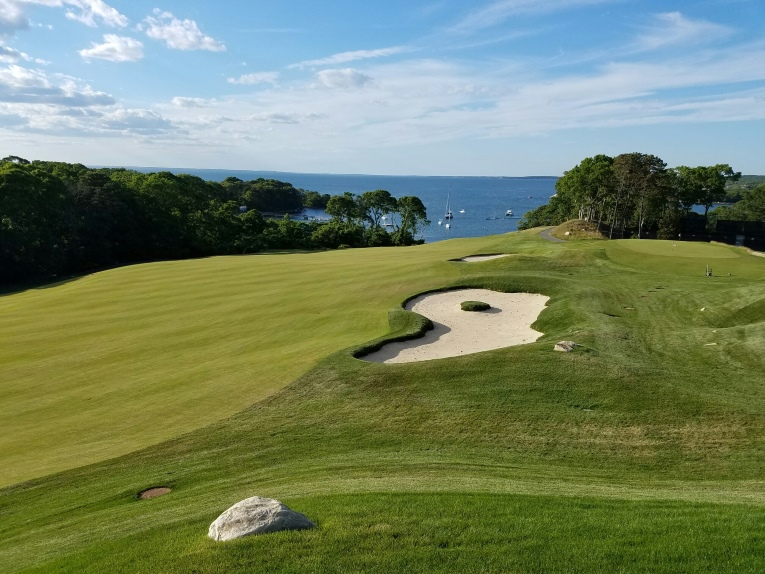
Newly completed work on #18 at Woods Hole, looking from high on the crest back toward the tee. Many of the rough areas will become native fescue/Blue Stem after grow in.
The most historic course at which you are consulting is Minikahda, where its roster of national champions includes the only two men to win the U.S. Open and U.S. Amateur in the same year, namely Bob Jones and Chick Evans. The course is the product of multiple architects: Willie Watson, Tom Bendelow, and a major overhaul by Donald Ross following the 1916 U.S. Open. In some ways, it reminds me of the California Golf Club of San Francisco, which is a hybrid of Alister MacKenzie’s work over A.V. Macan’s original underrated design. As Josh Smith jokes, it is a Macan-zie! You worked for Kyle Phillips at the Cal Club and saw first hand his approach there to tie the two styles together. Compare and contrast working on multi-architect courses versus a “pure” solo design like Mid Pines.
I really enjoyed the fact that Cal Club was the product of two talented architects that had different visions for the course. Macan’s and MacKenzie’s work shows that while distinct, the Good Doctor would bend his ideas to match Macan’s at times. When MacKenzie started there it was only a year and a half after the course opened. So he only did a couple of greens and all the bunkers. Inheriting Macan’s quirky shaping arrangements around the greens make the work unique. Overall I think it’s really cool to have two talented architects work on the same property. These hybrid designs stand out from their individual work. Cal Club is a very different design from Pasatiempo.
That uniqueness shows through at Minikahda. The course seems to benefit from its multiple designer pedigree. It’s impossible to cypher which architects built what, but several green sites appear much more pronounced than I suspect Ross would have done. Some of the wilder green sites seem inherited from Bendelow and Watson such as the 3rd and 17th for example. While the green sites on these holes are aggressive, the internal contours course-wide are a little softer than you would expect from Ross. At Minikahda you can expect to make a few more longer range birdie putts than you might at Plainfield or White Bear Yacht Club. The steep but gently contoured greens make for a good overall balance.
The bunkering schemes that give the course its consistent and superb character is clearly the genius of Ross. It’s already a well restored course, as Pritchard did some very nice work through the 2000’s. I’d seen the golf course after the work and was very impressed. So I’ve suggested working to reinstate some of the more unique Ross bunkering patterns that they might not have tackled in the first go round. And I was excited to see in their original aerial there are some fantastic opportunities in this category. The course’s original bunker compositions were impressive. A good example would be between the 2nd and 14th holes where there was a big array of bunkering right in front of the tees that is unique in all my travels.
What suggestions have you made to the club to further maximise the value of their multi-architect history?
The 6th hole at Minikahda is a Ross original. There was a little more short grass wrapped around the green in the 1920-30s photography. I suggested that we try to restore a little more of that feeling around the green site and recapture some fun quirky shots and variety. It’s a really cool hole. There are rumors that it’s the hole that inspired Bobby Jones when he hired Robert Trent Jones to remodel the 16th at Augusta – remembering his battles with the course in the 1927 U.S. Amateur. It has the same sweeping pond arrangement that everyone is familiar with that encourages a draw in The Masters — and a contrasting front right pin that demands a fade. So last fall we expanded the front pond according to Ross’s original plan, to effect the front left hole locations. We’ve put in a swath of short grass around the back-left of the green where the famous Tiger Woods shot took place at Augusta. Now you have a chance to play bumps, flop shots, or to putt or chip – maximum variety that was not possible in the last decades. For me it’s very cool to do good subtle work on a hole that has such a far-reaching historical impact. And it is always fun to start working on the kinds of features that members will enjoy.
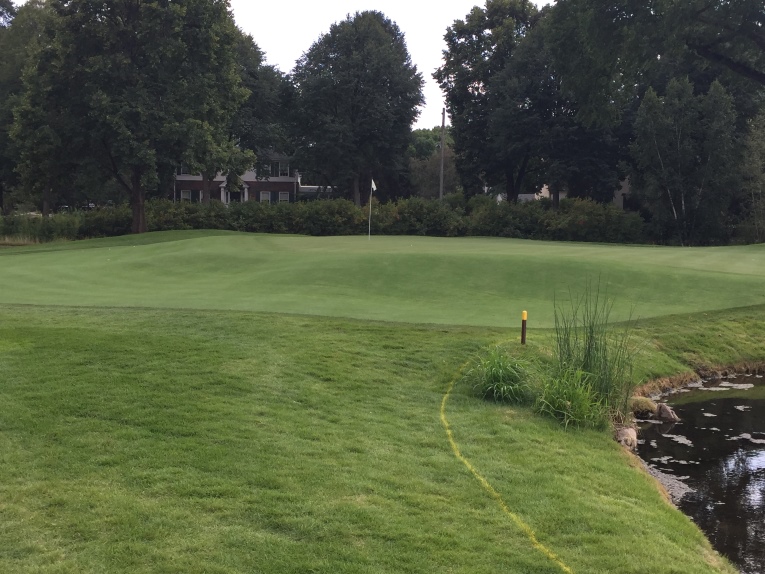
The 6th at Minikahda Club – where Bobby Jones won the 1927 U.S. Amateur – and apparently the possible hole that gave him inspiration for RTJ’s marching orders at #16 at Augusta National.
Otherwise we’ve discussed restoring some connected fairway arrangements. Willie Watson’s plans for the 18th and 1st had a connected fairway which he wrote was inspired by the Old Course. Several areas on the course have the opportunity for restoring these kinds of interesting features should the club decide to.
In addition to your solo pursuits, you have continued working for Gil Hanse on some interesting projects apart from Rio. What have been the highlights?
It has been a good run of diverse projects including brief stints at Quaker Ridge and Ross’s Sakonnet, Wianno, and Allegheny CC — as well as brief trips to work the newer stuff at Mossy Oak and Streamsong. We also completed a unique restoration of a Waverley Country Club in Oregon and overhaul of The Vineyard Golf Club. I also worked on one brief international project at Gavea Golf Club in Rio – which might have been the coolest course in the world in the 1930’s that no one knew about. My two favorite projects among them for Gil were Vineyards and Waverley:
Vineyards GC
Vineyard was a frustratingly un-walkable Donald Steel course which Gil overhauled entirely. The course is now the opposite with a visual mixture of Sand Hills, and early Garden City. We built some of the biggest bunkers I’ll probably ever build. However the design leaves an adequate amount of space to try play exciting ground shots – critical in summer winds of Martha’s Vineyard.
Waverley CC
A really neat club in the heart of Portland, right along the Willamette River and West Hills. Personally, it was great to return to the course most responsible for getting me interested in architecture as a junior golfer. H. Chandler Egan did work on the course in the 1920’s and Gil did a superb restoration job. His plan introduced a fantastic array of grassed face bunkers and interesting grassing arrangements. The closing stretch of Egan’s routing is outstanding along the waterfront – further buoyed by A.V Macan’s phenomenal 17th green complex. It made for a great restoration at a club that may have the friendliest membership in America.

Waverley features an outstanding set of one shot holes as well as a pair of par 5s to close the round. Pictured above is the 18th that plays along the river.
In your 2011 interview, and reflective of the lean times, you stated, “It should become a cornerstone priority of this business in the coming decades to improve the existing golf courses we already have.” You added, “Architects who can and are willing do the work themselves on a timetable and budget convenient to their business model make these projects viable. And when I say doing the work I mean all of it.” That has all come true at design-build projects like Mid Pines and Charleston. That now begs the question: what are the prospects for an original nine or eighteen hole design?
It’s hard to say but obviously the fact that the economy seems to be improving is opening a few more doors than it was five years ago.
I’d love to continue to work on the same kinds of projects, with great old golf courses like Pine Needles, Minikahda Club, or Charleston. These courses have had good restorations but still have amazing further potential for implementing the more edgy and unique aspects of the original design. Charleston is a prime example of this where we’ve just restored some of Raynor’s 8,000 square foot bunkers — big brush strokes on a good course and making great changes.
Projects where a given course has an incredibly high ceiling are very exciting to me. At Mid Pines we had that opportunity and we continue to improve it. If I was able to snap my fingers and make it happen, a completed Woods Hole master plan has the potential to be as good as anything I’ve worked on in my solo career. It’s a really cool place! As the economy improves I’m ready to take on a new phase in my career. If it’s on the right piece of land for the right client, I would love to do a Wild Horse type of model — a great course for great price with design/build ethos. I’m confident with my projects experience working on some of the best courses of the last decades that I’m ready to build a new course from scratch. Where and if that happens who knows. Obviously the US market is improving and it will be interesting to see if the South American market is viable. I would love to do a golf course on the right piece of land in Brazil or in the surrounding countries for a client committed to doing some special.
For guys who were in the business in the 2008 financial crash, it seemed like nothing was ever going to happen again. So it’s a great reversal in my career to be working on extremely rewarding projects moving my career forward—and getting firmly in position to capitalize when the chance comes to start putting my own ideas into the dirt. I would hope that in the next five years I get a shot at taking a piece of land from scratch and doing something really cool. I have spent plenty of time thinking of what my own style would be and trying to push the art form — not just copying everybody else’s work. Hopefully someday I get a chance to try it out and reward a client for taking a shot on someone young and new again.
The End




